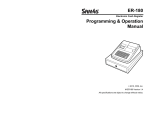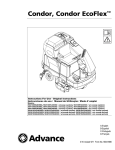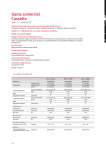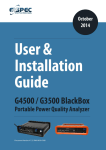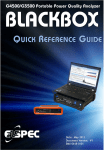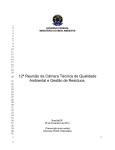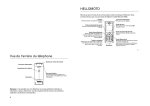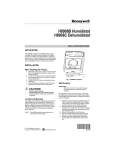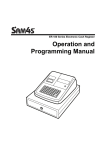Download Samsung ER-150 Specifications
Transcript
ER-150
ELECTRONIC CASH REGISTER
Programming &
Operation Manual
For Fast Startup, See
″Initial Setup″ on page 1
CRS, Inc.
www.crs-usa.com
© 2005, Cash Register Sales, Inc. M-ER150 Version 2.0
All specifications are object to change without notice.
CRS, Inc.
Limited Warranty and Disclaimers of Warranty
This manual has been developed by CRS, Inc. It is intended for the use of its customers
and service personnel and should be read in its entirety before attempting to install, use or
program the product(s).
Nothing contained in this manual shall be deemed to be, and this manual does not
constitute, a warranty of, or representation with respect to, the product or any of the
products to which this manual applies. This manual is subject to change without notice
and CRS, Inc. has no obligation to provide any updates or corrections to this manual.
Further, CRS, Inc. also reserves the right, without prior notice, to make changes in
equipment design or components as it deems appropriate. No representation is made that
this manual is complete or accurate in all respects and CRS, Inc. shall not be liable for
any errors or omissions contained in this manual. In no event shall CRS, Inc. be liable for
any incidental or consequential damages relating to or arising out of the use of this
manual. This document contains proprietary information that is protected by copyright.
All rights are reserved. No part of this document may be photocopied or reproduced
without prior written consent of CRS, Inc.
NOTICE
IF ANY WARRANTY IS EXTENDED TO YOU WITH REGARD TO THE
PRODUCT(S) TO WHICH THIS MANUAL APPLIES, IT IS A WARRANTY FROM
THE ENTITY OR INDIVIDUAL FROM WHOM YOU DIRECTLY PURCHASED
THE PRODUCT(S).
SUBJECT TO THE FOREGOING, UNLESS YOU ARE A DIRECT END USER
CUSTOMER OF CRS, INC., CRS, INC. DOES NOT EXTEND TO YOU ANY
EXPRESS WARRANTY OR ANY IMPLIED WARRANTY AND EXPRESSLY
DISCLAIMS ANY IMPLIED WARRANTY OF MERCHANTABILITY, FITNESS FOR
USE, OR FITNESS FOR ANY PARTICULAR PURPOSE, OR ANY WARRANTY OF
NON-INFRINGEMENT OF INTELLECTUAL PROPERTY RIGHTS IN
CONNECTION WITH THE PRODUCT(S) OR ANY SOFTWARE, DRIVERS, OR
PROGRAMMING PRODUCT, WHETHER EMBEDDED IN PRODUCT(S) OR
PROVIDED AS A SEPARATE PROGRAM, OR USED IN CONJUNCTION WITH
THIS/THESE PRODUCT(S). CRS, INC. SPECIFICALLY DOES NOT WARRANT
THAT THE OPERATION OF ANY DRIVERS, SOFTWARE, OR PROGRAMMING
PRODUCTS LICENSED HEREUNDER, WHETHER EMBEDDED IN PRODUCTS
OR PROVIDED AS SEPARATE PROGRAMS, SHALL BE UNINTERRUPTED OR
ERROR FREE OR THAT FUNCTIONS CONTAINED IN SUCH DRIVERS,
SOFTWARE OR PROGRAMMING PRODUCTS SHALL OPERATE IN
COMBINATION(S) WHICH MAY BE SELECTED FOR USE BY YOU OR
OTHERWISE MEET YOUR REQUIREMENTS.
CRS, Inc. is not responsible for any damages or loss, either direct, indirect, special,
incidental or consequential, which you may experience as a result of your purchase or use
of the product(s). Your sole remedy in the event that you encounter any difficulties with
the product(s) is against the entity or individual from whom you purchased the product(s).
Revision 2.0 - April 1, 2005
WARNING - U.S.
THIS EQUIPMENT GENERATES, USES AND CAN RADIATE RADIO
FREQUENCY ENERGY, AND IF NOT INSTALLED AND USED IN
ACCORDANCE WITH THE INSTRUCTIONS MANUAL, MAY CAUSE
INTERFERENCE TO RADIO COMMUNICATIONS. IT HAS BEEN TESTED
AND FOUND TO COMPLY WITH THE LIMITS FOR A CLASS A
COMPUTING DEVICE PURSUANT TO SUBPART J OF PART 15 OF FCC
RULES WHICH ARE DESIGNED TO PROVIDE REASONABLE
PROTECTION AGAINST SUCH INTERFERENCE WHEN OPERATED IN A
COMMERCIAL ENVIRONMENT. OPERATIONS OF THE EQUIPMENT IN
A RESIDENTIAL AREA IS LIKELY TO CAUSE INTERFERENCE IN WHICH
CASE THE USER, AT HIS OWN EXPENSE, WILL BE REQUIRED TO
TAKE WHATEVER MEASURES MAY BE REQUIRED TO CORRECT THE
INTERFERENCE.
NOTICE - CANADA
THIS APPARATUS COMPLIES WITH THE CLASS “A” LIMITS FOR RADIO
INTERFERENCE AS SPECIFIED IN THE CANADIAN DEPARTMENT OF
COMMUNICATIONS RADIO INTERFERENCE REGULATIONS.
CET APPAREIL EST CONFORME AUX NORMES CLASS “A”
D’INTERFERENCE RADIO TEL QUE SPECIFIER PAR MINISTRE
CANADIEN DES COMMUNICATIONS DANS LES REGLEMENTS
D’INTERFERENCE RADIO.
ATTENTION
The product that you have purchased may contain a battery that may be
recyclable. At the end of its useful life, under various state and local laws, it
may be illegal to dispose of the battery into the municipal waste system.
Check with your local solid waste officials for details concerning recycling
options or proper disposal.
TABLE OF CONTENTS
INITIAL SET UP INSTRUCTIONS
1
UNPACK THE CASH REGISTER ⋅⋅⋅⋅⋅⋅⋅⋅⋅⋅⋅⋅⋅⋅⋅⋅⋅⋅⋅⋅⋅⋅⋅⋅⋅⋅⋅⋅⋅⋅⋅⋅⋅⋅1
INSTALL OR REPLACE BATTERIES ⋅⋅⋅⋅⋅⋅⋅⋅⋅⋅⋅⋅⋅⋅⋅⋅⋅⋅⋅⋅⋅⋅⋅⋅⋅⋅⋅1
CLEAR RANDOM ACCESS MEMORY ⋅⋅⋅⋅⋅⋅⋅⋅⋅⋅⋅⋅⋅⋅⋅⋅⋅⋅⋅⋅⋅⋅⋅⋅2
LOAD PAPER ⋅⋅⋅⋅⋅⋅⋅⋅⋅⋅⋅⋅⋅⋅⋅⋅⋅⋅⋅⋅⋅⋅⋅⋅⋅⋅⋅⋅⋅⋅⋅⋅⋅⋅⋅⋅⋅⋅⋅⋅⋅⋅⋅⋅⋅⋅⋅⋅⋅⋅⋅⋅⋅⋅⋅⋅⋅⋅⋅⋅⋅⋅⋅⋅⋅⋅2
REPLACING THE INK ROLLER ⋅⋅⋅⋅⋅⋅⋅⋅⋅⋅⋅⋅⋅⋅⋅⋅⋅⋅⋅⋅⋅⋅⋅⋅⋅⋅⋅⋅⋅⋅⋅⋅⋅⋅⋅3
TAX STATUS PROGRAMMING ⋅⋅⋅⋅⋅⋅⋅⋅⋅⋅⋅⋅⋅⋅⋅⋅⋅⋅⋅⋅⋅⋅⋅⋅⋅⋅⋅⋅⋅⋅⋅⋅⋅⋅⋅4
ENTERING A FIXED RATE ⋅⋅⋅⋅⋅⋅⋅⋅⋅⋅⋅⋅⋅⋅⋅⋅⋅⋅⋅⋅⋅⋅⋅⋅⋅⋅⋅⋅⋅⋅⋅⋅⋅⋅4
DEPARTMENT STATUS ⋅⋅⋅⋅⋅⋅⋅⋅⋅⋅⋅⋅⋅⋅⋅⋅⋅⋅⋅⋅⋅⋅⋅⋅⋅⋅⋅⋅⋅⋅⋅⋅⋅⋅⋅⋅⋅⋅⋅⋅⋅⋅⋅⋅⋅⋅⋅⋅4
FEATURES
5
MODE SWITCH ⋅⋅⋅⋅⋅⋅⋅⋅⋅⋅⋅⋅⋅⋅⋅⋅⋅⋅⋅⋅⋅⋅⋅⋅⋅⋅⋅⋅⋅⋅⋅⋅⋅⋅⋅⋅⋅⋅⋅⋅⋅⋅⋅⋅⋅⋅⋅⋅⋅⋅⋅⋅⋅⋅⋅⋅⋅⋅⋅⋅⋅⋅5
DISPLAY ⋅⋅⋅⋅⋅⋅⋅⋅⋅⋅⋅⋅⋅⋅⋅⋅⋅⋅⋅⋅⋅⋅⋅⋅⋅⋅⋅⋅⋅⋅⋅⋅⋅⋅⋅⋅⋅⋅⋅⋅⋅⋅⋅⋅⋅⋅⋅⋅⋅⋅⋅⋅⋅⋅⋅⋅⋅⋅⋅⋅⋅⋅⋅⋅⋅⋅⋅⋅⋅⋅⋅⋅⋅5
KEYBOARD ⋅⋅⋅⋅⋅⋅⋅⋅⋅⋅⋅⋅⋅⋅⋅⋅⋅⋅⋅⋅⋅⋅⋅⋅⋅⋅⋅⋅⋅⋅⋅⋅⋅⋅⋅⋅⋅⋅⋅⋅⋅⋅⋅⋅⋅⋅⋅⋅⋅⋅⋅⋅⋅⋅⋅⋅⋅⋅⋅⋅⋅⋅⋅⋅⋅⋅⋅6
KEY FUNCTIONS ⋅⋅⋅⋅⋅⋅⋅⋅⋅⋅⋅⋅⋅⋅⋅⋅⋅⋅⋅⋅⋅⋅⋅⋅⋅⋅⋅⋅⋅⋅⋅⋅⋅⋅⋅⋅⋅⋅⋅⋅⋅⋅⋅⋅⋅⋅⋅⋅⋅⋅⋅⋅⋅⋅⋅⋅⋅7
PROGRAMMING
9
SETTING THE DECIMAL POINT ⋅⋅⋅⋅⋅⋅⋅⋅⋅⋅⋅⋅⋅⋅⋅⋅⋅⋅⋅⋅⋅⋅⋅⋅⋅⋅⋅⋅⋅⋅⋅⋅⋅9
DEPARTMENT STATUS ⋅⋅⋅⋅⋅⋅⋅⋅⋅⋅⋅⋅⋅⋅⋅⋅⋅⋅⋅⋅⋅⋅⋅⋅⋅⋅⋅⋅⋅⋅⋅⋅⋅⋅⋅⋅⋅⋅⋅⋅⋅⋅⋅⋅⋅⋅⋅9
TAX STATUS PROGRAMMING ⋅⋅⋅⋅⋅⋅⋅⋅⋅⋅⋅⋅⋅⋅⋅⋅⋅⋅⋅⋅⋅⋅⋅⋅⋅⋅⋅⋅⋅⋅⋅⋅⋅10
ENTERING A FIXED RATE ⋅⋅⋅⋅⋅⋅⋅⋅⋅⋅⋅⋅⋅⋅⋅⋅⋅⋅⋅⋅⋅⋅⋅⋅⋅⋅⋅⋅⋅⋅⋅⋅⋅⋅⋅⋅⋅⋅⋅⋅⋅10
FORMULATING A TAX TABLE ⋅⋅⋅⋅⋅⋅⋅⋅⋅⋅⋅⋅⋅⋅⋅⋅⋅⋅⋅⋅⋅⋅⋅⋅10
ENTERING THE TAX TABLE ⋅⋅⋅⋅⋅⋅⋅⋅⋅⋅⋅⋅⋅⋅⋅⋅⋅⋅⋅⋅⋅⋅⋅⋅⋅⋅⋅⋅⋅⋅⋅⋅⋅⋅⋅⋅12
SETTING THE PERCENT (%) KEY ⋅⋅⋅⋅⋅⋅⋅⋅⋅⋅⋅⋅⋅⋅⋅⋅⋅⋅⋅⋅⋅⋅⋅⋅⋅⋅⋅⋅13
MINUS (-) KEY PROGRAMMING ⋅⋅⋅⋅⋅⋅⋅⋅⋅⋅⋅⋅⋅⋅⋅⋅⋅⋅⋅⋅⋅⋅⋅⋅⋅⋅⋅⋅⋅⋅13
SETTING THE MACHINE NUMBER ⋅⋅⋅⋅⋅⋅⋅⋅⋅⋅⋅⋅⋅⋅⋅⋅⋅⋅⋅⋅⋅⋅⋅⋅⋅13
RECEIPT PRINT / JOURNAL PRINT ⋅⋅⋅⋅⋅⋅⋅⋅⋅⋅⋅⋅⋅⋅⋅⋅⋅⋅⋅⋅⋅⋅⋅⋅⋅⋅13
SYSTEM OPTIONS ⋅⋅⋅⋅⋅⋅⋅⋅⋅⋅⋅⋅⋅⋅⋅⋅⋅⋅⋅⋅⋅⋅⋅⋅⋅⋅⋅⋅⋅⋅⋅⋅⋅⋅⋅⋅⋅⋅⋅⋅⋅⋅⋅⋅⋅⋅⋅⋅⋅⋅⋅⋅⋅⋅14
STEP ONE OF SYSTEM PROGRAMMING ⋅⋅⋅⋅⋅⋅⋅14
STEP TWO SYSTEM PROGRAMMING ⋅⋅⋅⋅⋅⋅⋅⋅⋅⋅⋅⋅15
SETTING THE DATE ⋅⋅⋅⋅⋅⋅⋅⋅⋅⋅⋅⋅⋅⋅⋅⋅⋅⋅⋅⋅⋅⋅⋅⋅⋅⋅⋅⋅⋅⋅⋅⋅⋅⋅⋅⋅⋅⋅⋅⋅⋅⋅⋅⋅⋅⋅⋅⋅⋅⋅⋅15
REGISTER MODE OPERATION EXAMPLES
16
PERFORMING A NO SALE ⋅⋅⋅⋅⋅⋅⋅⋅⋅⋅⋅⋅⋅⋅⋅⋅⋅⋅⋅⋅⋅⋅⋅⋅⋅⋅⋅⋅⋅⋅⋅⋅⋅⋅⋅⋅⋅⋅⋅⋅16
NON ADD (REFERENCE) NUMBER ENTRIES ⋅⋅⋅⋅⋅⋅⋅⋅16
DEPARTMENT ENTRIES ⋅⋅⋅⋅⋅⋅⋅⋅⋅⋅⋅⋅⋅⋅⋅⋅⋅⋅⋅⋅⋅⋅⋅⋅⋅⋅⋅⋅⋅⋅⋅⋅⋅⋅⋅⋅⋅⋅⋅⋅⋅⋅⋅⋅16
MULTIPLE ITEM DEPARTMENT ENTRY ⋅⋅⋅⋅⋅⋅⋅16
SINGLE ITEM DEPARTMENT SALES ⋅⋅⋅⋅⋅⋅⋅⋅⋅⋅⋅⋅⋅17
MINUS (-) KEY OPERATION ⋅⋅⋅⋅⋅⋅⋅⋅⋅⋅⋅⋅⋅⋅⋅⋅⋅⋅⋅⋅⋅⋅⋅⋅⋅⋅⋅⋅⋅⋅⋅⋅⋅⋅⋅⋅⋅⋅17
PERCENT DISCOUNT OPERATION ⋅⋅⋅⋅⋅⋅⋅⋅⋅⋅⋅⋅⋅⋅⋅⋅⋅⋅⋅⋅⋅⋅⋅⋅⋅⋅17
REFUND PROCEDURE ⋅⋅⋅⋅⋅⋅⋅⋅⋅⋅⋅⋅⋅⋅⋅⋅⋅⋅⋅⋅⋅⋅⋅⋅⋅⋅⋅⋅⋅⋅⋅⋅⋅⋅⋅⋅⋅⋅⋅⋅⋅⋅⋅⋅⋅⋅⋅17
VOIDING ENTRIES (VD) ⋅⋅⋅⋅⋅⋅⋅⋅⋅⋅⋅⋅⋅⋅⋅⋅⋅⋅⋅⋅⋅⋅⋅⋅⋅⋅⋅⋅⋅⋅⋅⋅⋅⋅⋅⋅⋅⋅⋅⋅⋅⋅⋅⋅18
PAYMENT PROCEDURES ⋅⋅⋅⋅⋅⋅⋅⋅⋅⋅⋅⋅⋅⋅⋅⋅⋅⋅⋅⋅⋅⋅⋅⋅⋅⋅⋅⋅⋅⋅⋅⋅⋅⋅⋅⋅⋅⋅⋅⋅⋅18
CASH ⋅⋅⋅⋅⋅⋅⋅⋅⋅⋅⋅⋅⋅⋅⋅⋅⋅⋅⋅⋅⋅⋅⋅⋅⋅⋅⋅⋅⋅⋅⋅⋅⋅⋅⋅⋅⋅⋅⋅⋅⋅⋅⋅⋅⋅⋅⋅⋅⋅⋅⋅⋅⋅⋅⋅⋅⋅⋅⋅⋅⋅⋅⋅⋅⋅⋅⋅18
CHARGE ⋅⋅⋅⋅⋅⋅⋅⋅⋅⋅⋅⋅⋅⋅⋅⋅⋅⋅⋅⋅⋅⋅⋅⋅⋅⋅⋅⋅⋅⋅⋅⋅⋅⋅⋅⋅⋅⋅⋅⋅⋅⋅⋅⋅⋅⋅⋅⋅⋅⋅⋅⋅⋅⋅⋅⋅⋅⋅⋅⋅⋅⋅18
SPLITTING PAYMENT BETWEEN CASH &
CHARGE ⋅⋅⋅⋅⋅⋅⋅⋅⋅⋅⋅⋅⋅⋅⋅⋅⋅⋅⋅⋅⋅⋅⋅⋅⋅⋅⋅⋅⋅⋅⋅⋅⋅⋅⋅⋅⋅⋅⋅⋅⋅⋅⋅⋅⋅⋅⋅⋅⋅⋅⋅⋅⋅⋅⋅⋅⋅⋅⋅⋅⋅⋅18
TAX SHIFT PROCEDURE ⋅⋅⋅⋅⋅⋅⋅⋅⋅⋅⋅⋅⋅⋅⋅⋅⋅⋅⋅⋅⋅⋅⋅⋅⋅⋅⋅⋅⋅⋅⋅⋅⋅⋅⋅⋅⋅⋅⋅⋅⋅⋅⋅19
RECEIVED ON ACCOUNT (RA) OPERATION ⋅⋅⋅⋅⋅⋅⋅⋅⋅19
PAID OUT (PO) OPERATION ⋅⋅⋅⋅⋅⋅⋅⋅⋅⋅⋅⋅⋅⋅⋅⋅⋅⋅⋅⋅⋅⋅⋅⋅⋅⋅⋅⋅⋅⋅⋅⋅⋅⋅⋅⋅⋅19
MANAGEMENT REPORTS AND BALANCING
20
CASH DECLARATION ⋅⋅⋅⋅⋅⋅⋅⋅⋅⋅⋅⋅⋅⋅⋅⋅⋅⋅⋅⋅⋅⋅⋅⋅⋅⋅⋅⋅⋅⋅⋅⋅⋅⋅⋅⋅⋅⋅⋅⋅⋅⋅⋅⋅⋅⋅⋅20
SAMPLE FINANCIAL REPORT ⋅⋅⋅⋅⋅⋅⋅⋅⋅⋅⋅⋅⋅⋅⋅⋅⋅⋅⋅⋅⋅⋅⋅⋅⋅⋅⋅⋅⋅⋅⋅⋅⋅21
SYSTEM BALANCING EQUATIONS ⋅⋅⋅⋅⋅⋅⋅⋅⋅⋅⋅⋅⋅⋅⋅⋅⋅⋅⋅⋅⋅⋅⋅22
MAINTENANCE
22
SPECIFICATIONS
23
DIMENSIONS ⋅⋅⋅⋅⋅⋅⋅⋅⋅⋅⋅⋅⋅⋅⋅⋅⋅⋅⋅⋅⋅⋅⋅⋅⋅⋅⋅⋅⋅⋅⋅⋅⋅⋅⋅⋅⋅⋅⋅⋅⋅⋅⋅⋅⋅⋅⋅⋅⋅⋅⋅⋅⋅⋅⋅⋅⋅⋅⋅⋅⋅⋅⋅23
MODE KEY ⋅⋅⋅⋅⋅⋅⋅⋅⋅⋅⋅⋅⋅⋅⋅⋅⋅⋅⋅⋅⋅⋅⋅⋅⋅⋅⋅⋅⋅⋅⋅⋅⋅⋅⋅⋅⋅⋅⋅⋅⋅⋅⋅⋅⋅⋅⋅⋅⋅⋅⋅⋅⋅⋅⋅⋅⋅⋅⋅⋅⋅⋅⋅⋅⋅⋅23
KEYBOARD ⋅⋅⋅⋅⋅⋅⋅⋅⋅⋅⋅⋅⋅⋅⋅⋅⋅⋅⋅⋅⋅⋅⋅⋅⋅⋅⋅⋅⋅⋅⋅⋅⋅⋅⋅⋅⋅⋅⋅⋅⋅⋅⋅⋅⋅⋅⋅⋅⋅⋅⋅⋅⋅⋅⋅⋅⋅⋅⋅⋅⋅⋅⋅⋅⋅23
PRINTER ⋅⋅⋅⋅⋅⋅⋅⋅⋅⋅⋅⋅⋅⋅⋅⋅⋅⋅⋅⋅⋅⋅⋅⋅⋅⋅⋅⋅⋅⋅⋅⋅⋅⋅⋅⋅⋅⋅⋅⋅⋅⋅⋅⋅⋅⋅⋅⋅⋅⋅⋅⋅⋅⋅⋅⋅⋅⋅⋅⋅⋅⋅⋅⋅⋅⋅⋅⋅⋅⋅⋅23
DISPLAY ⋅⋅⋅⋅⋅⋅⋅⋅⋅⋅⋅⋅⋅⋅⋅⋅⋅⋅⋅⋅⋅⋅⋅⋅⋅⋅⋅⋅⋅⋅⋅⋅⋅⋅⋅⋅⋅⋅⋅⋅⋅⋅⋅⋅⋅⋅⋅⋅⋅⋅⋅⋅⋅⋅⋅⋅⋅⋅⋅⋅⋅⋅⋅⋅⋅⋅⋅⋅⋅⋅⋅23
POWER ⋅⋅⋅⋅⋅⋅⋅⋅⋅⋅⋅⋅⋅⋅⋅⋅⋅⋅⋅⋅⋅⋅⋅⋅⋅⋅⋅⋅⋅⋅⋅⋅⋅⋅⋅⋅⋅⋅⋅⋅⋅⋅⋅⋅⋅⋅⋅⋅⋅⋅⋅⋅⋅⋅⋅⋅⋅⋅⋅⋅⋅⋅⋅⋅⋅⋅⋅⋅⋅⋅⋅⋅⋅23
P / Z MODE SIGN ON CODE PROGRAMMING
24
TO ESTABLISH OR CHANGE THE SECRET CODE ⋅
⋅⋅⋅⋅⋅⋅⋅⋅⋅⋅⋅⋅⋅⋅⋅⋅⋅⋅⋅⋅⋅⋅⋅⋅⋅⋅⋅⋅⋅⋅⋅⋅⋅⋅⋅⋅⋅⋅⋅⋅⋅⋅⋅⋅⋅⋅⋅⋅⋅⋅⋅⋅⋅⋅⋅⋅⋅⋅⋅⋅⋅⋅⋅⋅⋅⋅⋅⋅⋅⋅⋅⋅⋅⋅⋅⋅⋅⋅⋅⋅⋅⋅24
ESTABLISHES CODE FOR Z MODE ⋅⋅⋅⋅⋅⋅⋅⋅⋅⋅⋅⋅⋅⋅⋅⋅⋅24
ESTABLISHES CODE FOR P MODE ⋅⋅⋅⋅⋅⋅⋅⋅⋅⋅⋅⋅⋅⋅⋅⋅⋅24
INITIAL SET UP INSTRUCTIONS
The following instructions aid in the initial set-up of the ER-150
Electronic Cash Register.
UNPACK THE CASH REGISTER
1. Un-box and unwrap the cash register.
2. The following items should be included in the box :
* 1 roll of register paper
* 1 take-up spindle (for journal tape)
* 2 ″AA″ batteries
* 1 battery compartment cover
INSTALL OR REPLACE BATTERIES
Open printer cover and locate battery
compartment.
Insert batteries with positive and
negative poles positioned as shown.
−
+
NOTE : This register comes with two ″AA″ alkaline
batteries for providing memory back-up in
case of a power failure. In order to assure
continuous battery back-up protection, it is
important to change batteries once each year.
1
CLEAR RANDOM ACCESS MEMORY (RAM)
AND INITIALIZE CASH REGISTER
1. Before plugging register in, place mode switch in P
position.
OFF R
X
Z
P
2. Connect the AC plug into a power outlet while
pressing the ″C″ and ″00″ keys.
3. RAM is now cleared of all memory and the register
prints a line of decimals (″........″).
NOTE : This is a one time only procedure to be performed
after the battery is first installed.
DO NOT CLEAR RAM ONCE THE REGISTER
IS PROGRAMMED OR PROGRAMS AND
TOTALS WILL BE LOST.
LOAD PAPER
1. Cut or tear the end of the register
tape evenly to insure proper
feeding through the printer.
2. Place paper roll in paper
compartment, with leading edge
of roll towards the rear of the
register, and feed the end of the
roll into the printer through
the paper guide.
2
3. Depress the ″FEED″ key until the paper begins to
advance through the printer.
4. If the paper refuses to feed through the printer, make
certain the end of the tape is square and that
it is routed properly.
FOR RECEIPT ONLY ...
5. Pass paper through the receipt
window of printer cover. Replace
over printer compartment.
FOR JOURNAL ONLY ...
6. Route paper over top of paper
guide and insert in the
slot of the take-up spool.
7. Press the ″FEED″ key to wind
paper securely on the spool.
8. Replace printer cover.
REPLACING THE INK ROLLER
Ink roller are disposable, and should not be re-inked. Re-inking
can cause damage to the printer that is not simply replace the
ink roller in the following manner :
1. Remove the old roller by lifting
straight up on the lever located
on the left side.
2. Place the new roller in position
(handle to the left) and snap it
into place by pressing it straight
down.
Lever
2
3
4
5
6
5
6
3
4
1
1
2
2
1
3
4
5
6
3
TAX STATUS PROGRAMMING
The ER-150 may be programmed to tax items
at either a straight percentage tax rate, or a tax table.
ENTERING A FIXED RATE
The ER-150 will accept a 5 digit tax rate, with the decimal
point fixed at three places (00.000). If your area taxes
goods based on a straight percentage, enter the rate in the
following manner.
Place mode switch in P position.
1
TAX
FIXED DECIMAL
1
0
6
5
0
0
TAX
= 6.5%
PRESS 1, ENTER THE FIVE DIGIT TAX RATE,
PRESS ″TAX″
DEPARTMENT STATUS
Enter the department status digit and press DPT1 or
DPT2 to set the status to be either taxable or
nontaxable, and to designate the department as a
single item department.
When a department is designated as a single
department, the register will finalize the sale as a cash
transaction immediate following the amount entry.
Place mode switch in P position.
DEPARTMENT STATUS DIGIT VALUES ARE
0 Regular department, nontaxable
1 Regular department, taxable
2 Single item department, nontaxable
3 Single item department, taxable
4
FEATURES
MODE SWITCH
OFF - Turns the cash register off. None of the keys will
respond when in the off position.
R - Register (on) mode.
X - ″Read″ mode for financial and Cash In Drawer
reports. Totals are NOT zeroed.
Z - ″Reset″ mode for financial and Cash In Drawer
reports. All totals return to zero.
P - Programming position.
DISPLAY
The operator display features a nine place digital
display providing the operator with information while
operating the cash register. During operations, the
display will show the following symbols. All these
symbols appear in the left-most position of the display.
123456789
C : Indicates the amount displayed is due in change to
the customer.
= : Indicates the amount displayed is the amount due
total.
- : Indicates the amount displayed is a negative
amount.
E : Indicates an error condition. Press ″C″ key to clear.
S : Indicates the amount displayed is a subtotal.
5
KEYBOARD
OFF R X Z P
RA
PO
X/RF
−
7
8
9
TAX
#/NS
%
4
5
6
DPT2
CH
VD
1
2
3
DPT1
SUB
TOTAL
C
0
FEED
6
00
CASH
TEND
KEY FUNCTIONS
FEED
Advances paper in printer.
0 - 9, 00
Numeric keypad for entering amounts.
DPT1
DPT2
Departments 1 and 2 allow the user to
classify items into two categories, each with
its own total and tax status.
X/RF
Used for multiplication entry (X), or to refund
sales amounts for merchandise returns.
PO
Used to register money Paid Out of the cash
drawer.
RA
Registers amounts Received on Account.
−
Registers dollar amount markdowns, or
coupons tendered.
%
Used to register percentage discount on
items or total sale. A set rate may be
programmed, or variable rates entered when
no automatic rate is set. The decimal is set
at two places (00.00).
VD
For voiding entries before a sale is finalized.
C
Clears incorrect entries made on the numeric
keys, or to silence the error tone after entry
errors.
7
TAX
Used to program the tax rate in P mode.
Also reverses the tax status when pressed
after the amount, and before the department
key. (nontaxable department add tax,
taxable department forgive tax, this item
only.)
#/NS
Used to print a reference number (#) on the
receipt or journal, or to open the cash drawer
outside of a sale (No Sale).
CH
CHarge tender key.
Keep a separate total from cash sales.
SUB
TOTAL
CASH
TEND
8
Display transaction subtotal, including tax.
Finalizes sales paid in cash and calculates
change due.
PROGRAMMING
Read this entire section carefully in order to program your
machine to best fit your individual needs.
* MODE SWITCH IN THE P POSITION. *
SETTING THE DECIMAL POINT
Enter 0 and press the ″X/RF″ key for 2 digit decimal
(0.00).
Enter 1 and press the ″X/RF″ key for 0 digit decimal
(000.).
DEPARTMENT STATUS
Enter the department status digit and press DPT1 or
DPT2 to set the status to be either taxable or
nontaxable, and to designate the department as a
single item department.
When a department is designated as a single
department, the register will finalize the sale as a cash
transaction immediate following the amount entry.
0
1
2
3
DEPARTMENT STATUS DIGIT VALUES ARE
Regular department, nontaxable
Regular department, taxable
Single item department, nontaxable
Single item department, taxable
9
TAX STATUS PROGRAMMING
The ER-150 may be programmed to tax
items at either a straight percentage tax rate, or
on a tax table entered into the machine during this
phase of program-ming.
ENTERING A FIXED RATE
The ER-150 will accept a 5 digit tax rate,
with the decimal point fixed at three places (00.000). If
your area taxes goods based on a straight percentage,
enter the rate in the following manner.
1
TAX
FIXED DECIMAL
1
0
6
5
0
0
TAX
= 6.5%
PRESS 1, ENTER THE FIVE DIGIT TAX RATE, PRESS
″TAX″
FORMULATING A TAX TABLE
In some locales were taxes do not follow flat percentage
rates, it is necessary to enter the tax rate as a table.
Before beginning tax table programming, obtain a local
tax chart and determine tax breaks for your area.
Determine the lowest amount to be taxed, and the amount
of tax that is added at that point (some states add .05 at the
first breakpoint). Next determine the tax break points by
checking the chart for the highest amount allowed before
each penny of tax is added. The difference between the
high amounts before each penny is added determine the
tax break point.
10
As break points are determined, a pattern will appear.
Once the pattern has developed, it is repeated for all
remaining amounts. However, the first few break points
will not fit this pattern. They are referred to as non-repeat
breaks.
•
The ER-150 allows for 20 breakpoints to establish
repeated tax break pattern. Should you make a mistake
in entering the break points, depress the ″C″ key to clear
and re-enter the table from the beginning. The following
example is for an Illinois 4% tax.
TAX
AMOUNT
0
RANGE
BREAKPOINT COMMENTS
.00 - .12
−
1
.13 - .31
19
2
.32 - .54
23
3
.55 - .81
27
4
5
6
.82 - 1.08
1.09 - 1.37
1.38 - 1.62
27
29
25
7
8
9
10
1.63 - 1.87
1.88 - 2.12
2.13 - 2.37
2.38 ⋅⋅⋅⋅⋅⋅⋅⋅⋅
25
25
25
First taxable
amount = .13
Difference
between .12 & .31
Difference
between .31 & .54
Difference
between .54 & .81
ETC.
Repeating
breakpoints begin
Pattern
established
11
ENTERING THE TAX TABLE
1
3
TAX
LOWEST AMOUNT CHARGED TAX
1
TAX
AMOUNT OF FIRST TAX ADDED
1
9
TAX
FIRST NON-REPEAT TAX BREAK
2
3
TAX
NEXT NON-REPEAT TAX BREAK
2
7
TAX
NEXT NON-REPEAT TAX BREAK
2
7
TAX
NEXT NON-REPEAT TAX BREAK
2
9
TAX
LAST NON-REPEAT TAX BREAK
CH
2
5
TAX
SIGNALS END OF NON-REPEAT,
BEGINNING OF REPEATING
BREAKPOINTS.
REPEAT BREAKPOINT
2
5
TAX
REPEAT BREAKPOINT
2
5
TAX
REPEAT BREAKPOINT
2
5
TAX
REPEAT BREAKPOINT
CASH EXITS TAX TABLE PROGRAMMING
TEND
CAUTION : PRESSING THE CASH KEY ANY OTHER TIME IN
PROGRAM MODE WILL ERASE ALL TAX PROGRAMMING.
12
SETTING THE PERCENT(%) KEY
N1
N2
N3
N4
N5
%
VALUE
N1-N4 Percentage rate with decimal fixed at two places(00.00).
N5
0 = Tax calculated after % discount is applied.
1 = Tax calculate before % discount is applied.
1
0
0
0
0
%
= 10%
MINUS (−) KEY PROGRAMMING
N1
−
N1
0
1
VALUE
Tax calculated after coupon is applied.
Tax calculated before coupon is applied.
SETTING THE MACHINE NUMBER
N1
N2
#/NS
ENTER A TWO DIGIT ID # FOR N1 & N2
•
The machine number prints on the receipt / journal tape along
side the transaction number.
RECEIPT PRINT / JOURNAL PRINT
N1
SUB
TOTAL
N1
VALUE
0 Receipt Print (advances extra paper)
1 Journal Print
13
SYSTEM OPTIONS
System option programming deals with aspects of
programming not associated with any particular key, but
with the general operation of the register. Each of the
options may be turned on or off in this phase of
programming. Five options are set with each five digit
entry, for a total of ten. When changing the setting of a
single option, the four accompanying options must also be
re-entered.
STEP ONE OF SYSTEM PROGRAMMING
All options have a value of zero as an initial setting.
N1
N2
N3
NO
OPTION
N1
CASH
DECLARATION
SKIP ZERO
TOTALS FOR
REPORTS
DUPLICATE Z
REPORTS
TOTAL REFUNDS
& VOIDS TO PRINT
ON REPORTS
SUBTOTAL TO
PRINT
N2
N3
N4
N5
14
N4
N5
RA
VALUE = 0
VALUE = 1
(Default settings
are 0.)
NOT
COMPULSORY
COMPULSORY
NO SKIP
SKIP
NO
DUPLICATE
PRINT
DUPLICATE
PRINT
NOT PRINT
NOT PRINT
STEP TWO OF SYSTEM PROGRAMMING
N1
NO
N1
N2
N3
N4
N5
N2
N3
N4
N5
PO
OPTION
VALUE = 0
GRAND TOTAL
PRINT
TO PRINT
GRAND TOTAL NOT RESET
TO RESET WITH
Z REPORT
Z COUNTER TO NOT RESET
RESET WITH Z
REPORT
TRANSACTION NOT RESET
NUMBER TO
RESET WITH Z
REPORT
PRINT DATE ON
PRINT
RECEIPT
(JOURNAL)
VALUE = 1
NOT PRINT
RESET
RESET
RESET
NOT PRINT
SETTING THE DATE
•
SET MODE SWITCH TO THE ″X″ POSITION.
The date must be programmed on a daily basis and will be
printed on all transaction receipts and report printouts (if
programmed to do so). To program the six digit number,
and press the ″CH″ key.
M
M
D
D
Y
Y
CH
0
9
1
3
9
9
CH
=09-13-99
15
REGISTER MODE OPERATION EXAMPLES
MODE SWITCH SET TO ″R″ POSITION
This section provides examples of transaction in the
register mode. When an error occurs, the ″C″ key. Error
conditions may be caused by incorrect entries or keys
pressed in the wrong order.
•
PERFORMING A NO SALE
Pressing the no sale (#/NS) key causes the cash drawer to
open outside of a sale, and for the no sale activity counter
on the financial report to be incremented.
NON ADD (REFERENCE) NUMBER ENTRIES
The ″#/NS″ key may also be used to print up to seven
digits for reference on the receipt / journal. The entry can
be made prior to any operation in the register mode. This
number will not add to any totals or counts.
To use this feature, simply enter a 1-7 digit number and
press the department or function key.
DEPARTMENT ENTRIES
MULTIPLE ITEM DEPARTMENT ENTRY
Enter the number of items with the same price,
press the ″X/RF″ key,
enter the item price and press the department key.
Finalize the sale.
16
SINGLE ITEM DEPARTMENT SALES
Enter the amount,
press the single item department.
Register will ring up amount, finalize sale to cash and
open drawer. If items have been entered to a regular
department as first entry in a sales transaction, and an
entry is made into the single item department, it will not
finalize the sale automatically but act as a regular
department.
MINUS (−) KEY OPERATION
After making an amount entry into a department you may
deduct a coupon or markdown by entering the amount to
be deducted and pressing the minus ″−″ key. The MINUS
key may be used in conjunction with the multiplication
″X/RF″ key, and also outside a sale.
PERCENT DISCOUNT OPERATION (%)
The percentage discount key may be used to either apply a
discount to a single item (item discount) or to an entire
sale (subtotal discount). When applying an item discount,
enter the percentage rate and press the ″%″ key. The
register will now re-display the amount due, less the
discount amount.
REFUND PROCEDURE
Press the ″X/RF″ key,
enter the amount to be refunded,
press the related department key,
press the appropriate tender key.
17
VOIDING ENTRIES (VD)
If you should make an incorrect amount / department
entry you may correct it with the void (VD) key in one
of two ways. If the item to be void is the last item
entered, simply press the ″VD″ key, and the register
will remove the very last item entered. To void an item
inside a transaction that was not immediately
preceding item, enter the amount to be voided, press
the ″VD″ key, and press the affected department.
PAYMENT PROCEDURES
CASH
There are two operations for closing a transaction to cash :
First, after entering all items, press the ″CASH
TEND″ key. Second, if you desire the register to
calculate change due, enter the amount tendered, and
press ″CASH TEND″.
The amount due back in change is then displayed.
CHARGE
Amount entry on the CHarge key is not allowed.
So, to use the CHarge key for tendering, simply enter all
items and press the CHarge key to finalize the transaction.
SPLITTING PAYMENT BETWEEN CASH &
CHARGE
After entering a items, press SUBTOTAL.
Enter the cash amount tendered first (the cash drawer will
not open at this time).
Press the CHarge key to finalize, and open drawer.
18
TAX SHIFT PROCEDURE
The TAX key us used to reverse the tax status of a
single department entry. That is, to make what would
normally be a taxable entry non-taxable, or a nontaxable entry taxable.
It may also used to exempt an entire sale from tax.
To reverse the tax status of an individual item, enter the
price of the item, press TAX, then press the normal
department key.
To exempt an entire sale from tax, ring all items,
press SUBTOTAL,
press TAX,
finalize sale with either CASH or CHarge.
RECEIVED ON ACCOUNT (RA) OPERATION
Enter the amount received on account and press the
RA key.
PAID OUT (PO) OPERATION
Enter the amount to be paid out and press the PO key.
19
MANAGEMENT REPORTS AND BALANCING
MODE
REPORT
CASH
X
DECLARATION
READ FINANCIAL
X
REPORT
RESET FINANCIAL
Z
REPORT
•
ENTRY
$ AMOUNT SUBTOTAL
CASH
CASH
These reports are explained in detail below.
CASH DECLARATION
The cash declaration feature, if made compulsory in
option programming, will enforce the entry of the total
Cash In Drawer before allowing financial reports to be
taken. This feature does not allow cashiers to mislead
management by altering overages and shortages to their
advantage.
The C.I.D. amount should be entered in the following way
After allowing for the beginning bank, count the
remaining cash to be deposited.
Place the cash deposit amount and press the SUBTOTAL
key.
The ER-150 now issues a receipt showing the total cash
declared, the cash total from memory, and the difference
between the two as either over or short. The ER-150 will
not allow any transactions to take place after cash
declaration has been performed until the financial report
has been reset in ″Z″ mode.
20
SAMPLE FINANCIAL REPORT
09-13-99
004
Z
012 @
54•24TX1
001 @
1•25 2
3•20TX
0•00 %−
0•00 −
58•69 * 1
0•00RF
−4•00VD
58•69 * 2
008 #
32•59CA
26•10CH
10•00RA
20•00PO
22•59AT
004 NS
•••••••••
190770•43 * 3
064−01
DATE
Z COUNTER, MODE SWITCH
POSITION
DPT1 COUNTER
DPT1 SALES TOTAL
DPT2 COUNTER
DPT2 SALES TOTAL
TAX TOTAL
% DISCOUNT TOTAL
− (COUPONS/MARKDOWNS) TOTAL
NET SALES TOTAL
REFUND TOTAL
VOID TOTAL
GROSS SALES TOTAL
CUSTOMER COUNT
CASH TOTAL
CHARGE TOTAL
RECEIVED ON ACCOUNT
PAID OUT
CASH DECLARED
NO SALE COUNTER
GRAND TOTAL
TRANSACTION NUMBER−
MACHINE NUMBER
21
SYSTEM BALANCING EQUATIONS
NET SALES TOTAL = DEPARTMENT TOTALS
+ TAX
− % DISCOUNT TOTAL
− (−) COUPON / MARKDOWN
TOTAL
GROSS SALES
= NET SALES TOTAL
+ REFUNDS
+ (−) COUPON / MARKDOWN
TOTAL
+ % DISCOUNTS
NEW GRAND TOTAL = TODAY′S GROSS SALES
+ PREVIOUS GRAND TOTAL
MAINTENANCE
1. Avoid excess dust and extreme temperatures.
2. Be certain that AC cord is inserted firmly in the
outlet, and that cord poses no danger of accidental
tripping.
3. Use no chemicals or abrasives while cleaning
cabinet or keyboard.
4. Do not pull or hold paper while the register is
printing.
22
SPECIFICATION
DIMENSIONS
REG. SIZE (SM DRAWER)
NET WEIGHT (SM DRAWER)
12.8″W × 16.54″L × 8.86″H
10 lb.
36 oz. (5 kg)
DRAWER
SIZE
WEIGHT
12.8″W × 16.54″L × 3.74″H
6 lb.
84 oz. (3.3 kg)
MODE KEY
LOCK SWITCH
POSITIONS
RECEIPT ON / OFF
SLIDE SWITCH
5 (OFF, R, X, Z, P)
NONE (PROGRAMMABLE)
KEYBOARD
TYPE
NUMBER OF KEYS
KEYSTROKE BUFFER
RUBBER CONTACT TYPE
26
8
PRINTER
MODEL #
STATIONS
PAPER
COPY
PRINT SPEED
M−42V
ONE
SINGLE PLY(57.5 mm OR 40 mm)
NONE
2.2 LINES per SECOND
DISPLAY
DIGITRON
CAPACITY
SYMBOLS
# 97D6
9 DIGITS
5 (E, C, -, =, S)
POWER
INPUT
CONSUMPTION
MEMORY BACK-UP
BATTERY
110V AC { 10%, 50 / 60 Hz
STANDBY : 2W, MAX : 8W
1 YEAR
AA ALKALINE 1.5 V × 2, OR
EQUIVALENT
23
P/Z MODE SIGN ON CODE PROGRAMMING
The ER-150 has the added feature of an extra
security function to limit access to certain phases of
operation.
Through optional programming, you may require a four
digit code before allowing access to the Z and
Programming modes.
When the mode switch is changed to a protected mode,
the buzzer sounds until the switch is returned to an
unprotected mode. If no mode protection is required then
you may disregard this section.
TO ESTABLISH OR CHANGE
THE SECRET CODE
1. Switch the mode lock to the ″X″ position, press No Sale
(#/NS), enter the four digit code,
•
press the RA key for Z mode protection.
•
press the PO key for P mode protection.
ESTABLISHES CODE FOR Z MODE
#/NS
RA
FOUR DIGITS
ESTABLISHES CODE FOR P MODE
#/NS
PO
FOUR DIGITS
24
NOTE : THE FOUR DIGIT CODE PROTECTION CAN
BE DISABLED BY ENTERING BEFORE
FOUR ZERO′S AS THE CODE NUMBER
USING THE SAME SEQUENCE AS ABOVE.
2. To enter the Z or P modes once protection is
established, place the mode switch in the ″X″
position and press the (−) minus key, enter your four
digit code and press the % discount key.
SAFETY NOTICE
The socket-outlet shall be installed near the
equipment and shall be easily accessible.
25































